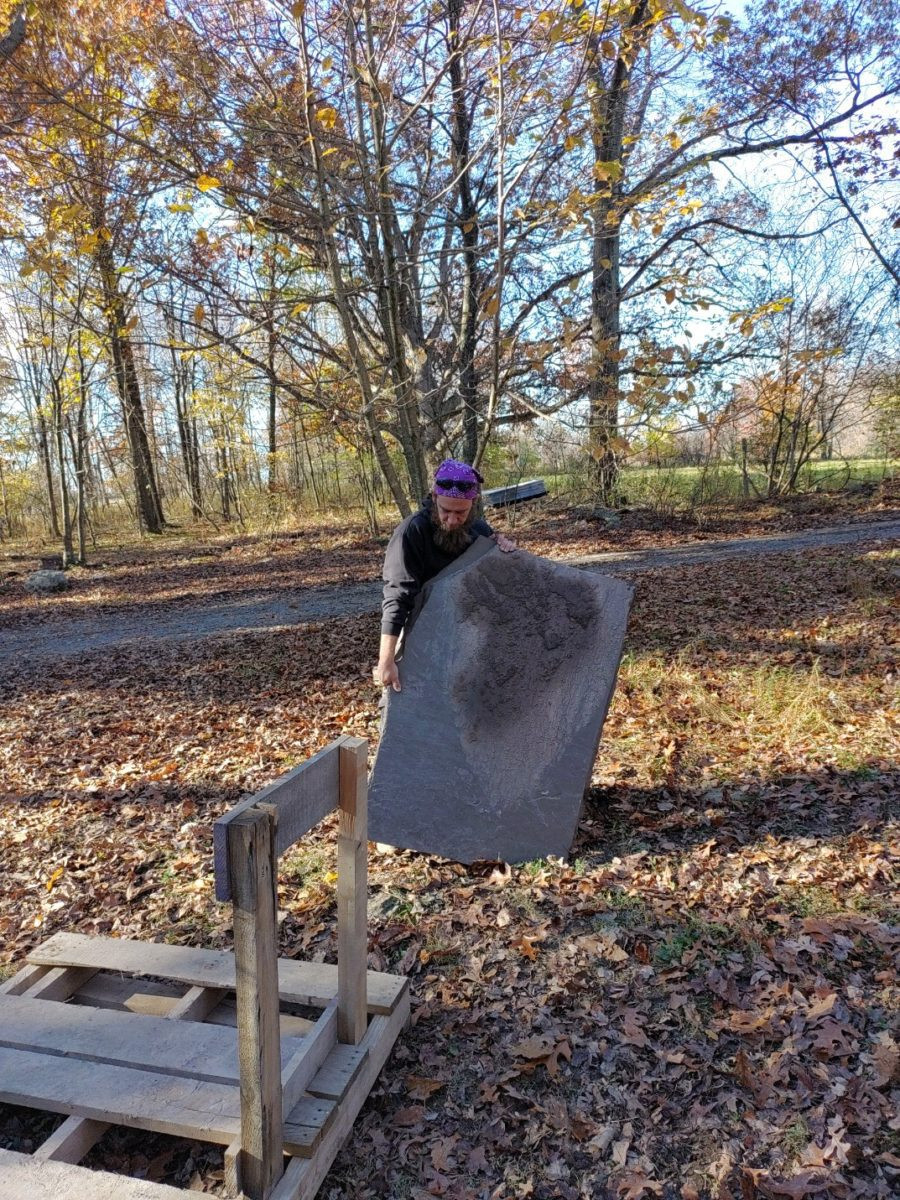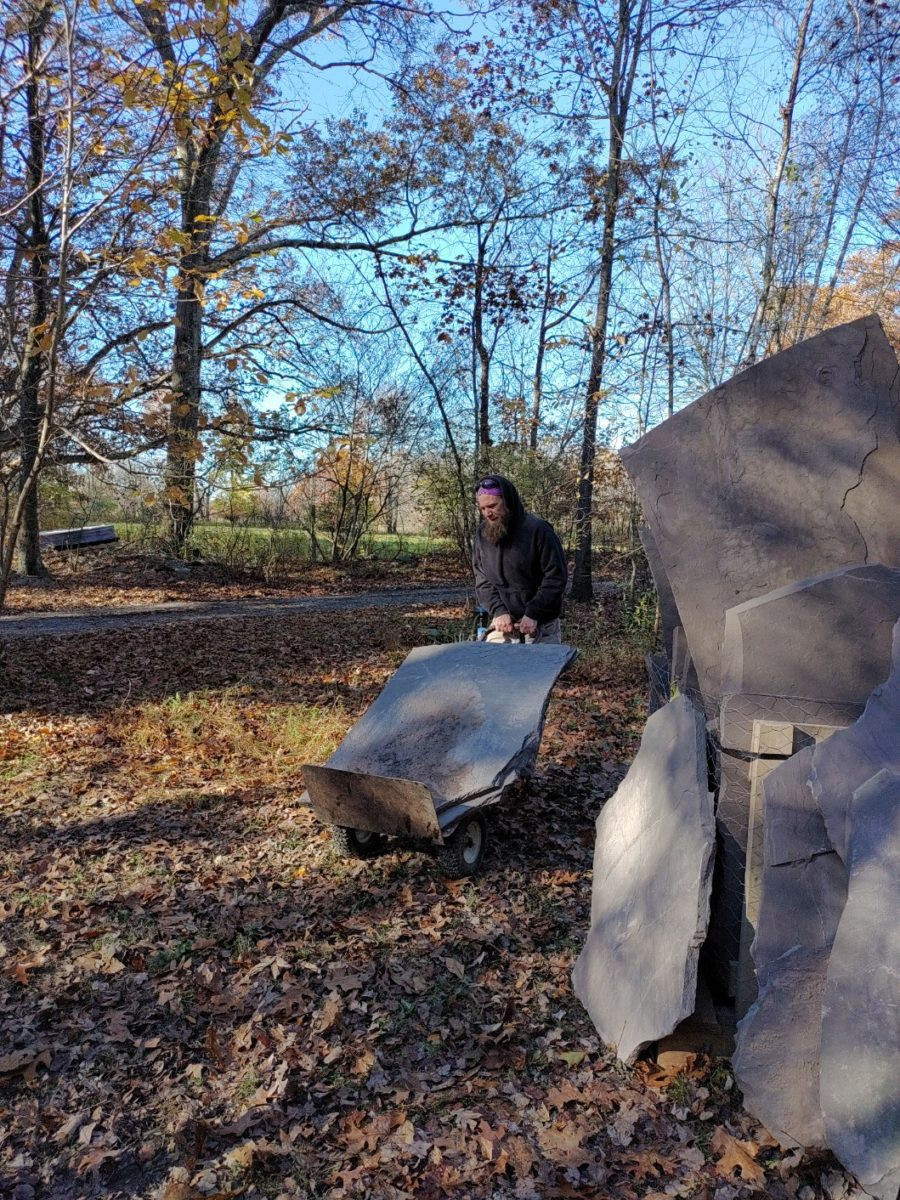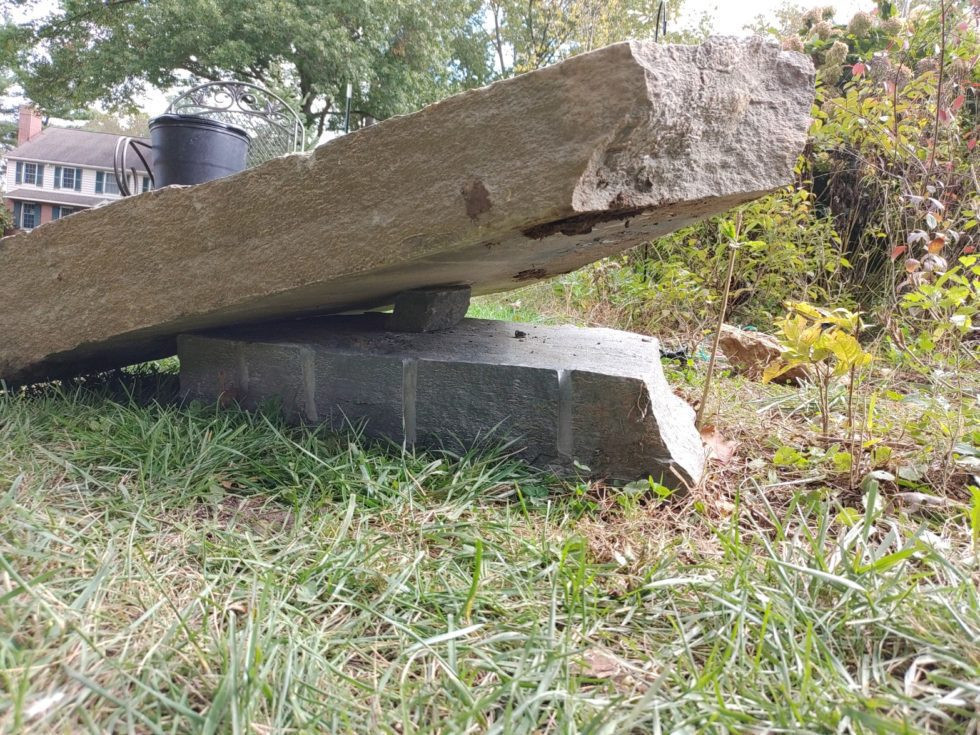Moving big rocks can seem daunting, but with the right techniques, it’s achievable. Rockscapes.net provides expert advice and innovative solutions for handling heavy stones in your landscaping projects. Discover effective methods and transform your outdoor spaces with ease, incorporating natural stone features into your landscape design.
Table of Contents
- Walk Large Stones
- Utilize a Dolly
- Create a Pivot Point
- Employ Rollers
- Lifting Techniques
- Flipping Heavy Stones
- Gantry Crane System
- Safety Precautions
- FAQ
1. How Can You Walk Large Stones Effectively?
Walking large stones involves standing slabs upright and moving them corner to corner. When faced with a pallet of large flagstones, new workers might feel overwhelmed, but this method allows you to handle them efficiently. This is similar to the wheel method, where you stand up the slab and roll it as if it were circular. Often, you might walk a large slab for about 10 feet and then wheel it for the last few feet to navigate obstacles.
The wheel method is a variation of the walking method, used more often. Just stand the slab up and pretend you’re inventing the wheel with an unlikely shape.
 Moving heavy rocks without machinery
Moving heavy rocks without machinery
2. Why Should You Utilize a Dolly for Moving Rocks?
Using a sturdy dolly is invaluable for moving heavy stones efficiently and safely. Investing in the largest, most robust dolly you can find will allow you to move even heavy boulders with relative ease. A high-quality dolly can significantly reduce the physical strain involved in moving landscaping rocks.
 Moving heavy stones using a dolly
Moving heavy stones using a dolly
3. How Do You Create a Pivot Point to Move Heavy Stones?
Creating a pivot point involves prying up the stone and strategically placing rocks to act as levers. This method allows you to spin and adjust the stone’s position with less effort. First, use the blade end of your mattock to pry under the stone. Turn the mattock to its side to lift the stone slightly. Then, slide a rock under the edge of the stone and remove the mattock. Next, slide another rock into the middle of the stone.
Pry up the stone again and remove the first rock from the edge. Now, the heavy stone is situated with a pivot point at the center. This lever system lets you spin the stone easily, turning it 180 degrees or see-sawing one side higher to place a larger pivot stone underneath.
To make spinning easier, use stone balls or gravel chunks under the heavy stone for smoother movement.
 Pivot point for moving large stones
Pivot point for moving large stones
4. What Are the Benefits of Employing Rollers for Moving Rocks?
Employing rollers, such as steel pipes, reduces the friction and effort needed to move heavy stones across the ground. This technique is especially useful for longer distances and uneven terrains. Pry up the stone and slide steel pipes underneath. Use multiple rollers to distribute the weight evenly. Then, push or pull the stone using a rope or tow strap.
5. What Are Effective Techniques for Lifting a Heavy Stone Off the Ground?
Lifting a heavy stone off the ground requires technique and leverage rather than brute strength. When a stone seems too heavy for two people to lift safely, it’s often better for one person to handle it alone using these methods.
- Stand the Stone Upright: Roll the stone onto another stone to gain initial height.
- Balance on Your Thigh: Lean the stone against your thigh, balancing it across your leg to lift it completely off the ground.
- Heft and Transfer: Once balanced, get your hands under it and lift it to your waist in one motion, then transfer it to its final location, such as a truck bed or wall.
6. How Can You Flip Over a Stone That Is Too Heavy to Lift?
Flipping a heavy stone involves a series of controlled prying and propping actions to gradually turn it over.
- Initial Pry: Use a pickaxe or mattock to pry the stone off the ground by an inch or so.
- Insert Small Stone: Slide a small stone under the lifted edge to maintain the height.
- Higher Pry: Pry the stone up 4 to 7 inches and slide a bigger rock under it.
- Final Lift: With the stone halfway upright, put down the tool and lift the stone into a standing position.
Once the stone is upright, you can move it onto a dolly and wheel it across the job site or use a chain to wrap it and lift it with a gantry crane.
7. When Should You Invest in a Gantry Crane System?
Investing in a gantry crane, crane trolley, and chain hoist is beneficial for projects involving extremely heavy stones or repetitive lifting. While it’s a significant investment, the increased efficiency and reduced physical strain can be worthwhile.
 Moving heavy stones with gantry crane
Moving heavy stones with gantry crane
Using a gantry crane allows for precise placement of large stones, which is crucial for building retaining walls, steps, or other landscape features. Before investing, develop other techniques to handle heavy stones, as the experience will enhance your ability to use the crane effectively.
8. What Safety Precautions Should You Take When Moving Heavy Stones?
Safety is paramount when moving heavy stones. Proper techniques and precautions can prevent injuries and ensure a safe working environment.
Key Safety Tips:
| Precaution | Description |
|---|---|
| Avoid Grunting | If you’re grunting, you’re likely using incorrect techniques. |
| Stretch and Hydrate | Always stretch before and during work, and stay hydrated. |
| Proper Lifting | Avoid twisting your back while lifting. Use your legs and core muscles. |
| Use Your Head | Think about the easiest and safest way to move a stone, minimizing strain on your body. |
| Body Mechanics | Maintain good body mechanics by using your knees, arms, and back in coordination. |
| Flat-Rate Awareness | Even if you’re paid a flat rate, prioritize your health and well-being over speed. |
| Easier Ways | Always look for easier, less straining methods to move stones, even if they take a bit longer. |
| Regular Breaks | Take regular breaks to prevent fatigue and reduce the risk of injury. |
| Wear Protective Gear | Use appropriate safety gear, including gloves, sturdy boots, and eye protection. According to the Occupational Safety and Health Administration (OSHA), wearing proper personal protective equipment can significantly reduce the risk of injuries on the job site. |
9. FAQ: Moving Big Rocks
| Question | Answer |
|---|---|
| What is the best way to move large rocks by myself? | Use techniques like walking the stone, creating a pivot point, or employing rollers to reduce the effort required. |
| How can I move rocks without heavy machinery? | Utilize methods such as dollies, rollers, and levers to move stones manually. |
| What tools are essential for moving big rocks? | Essential tools include a sturdy dolly, mattock, digging bar, steel pipes for rollers, and potentially a gantry crane system for very heavy stones. |
| How do I lift a heavy rock safely? | Stand the stone upright, balance it on your thigh, and use your legs and core to lift, avoiding back strain. |
| What should I do if a rock is too heavy to lift? | Use a combination of prying and propping techniques to gradually lift and flip the stone, or invest in a gantry crane system. |
| How can I create a rock garden easily? | Start by planning your design, then use techniques like pivot points and rollers to position the rocks effectively. |
| What safety measures should I take? | Always stretch, hydrate, use proper lifting techniques, and wear protective gear to prevent injuries. |
| Where can I find quality landscaping rocks? | Rockscapes.net offers a wide selection of landscaping rocks and expert advice on choosing the right stones for your project. Located at 1151 S Forest Ave, Tempe, AZ 85281, United States, Phone: +1 (480) 965-9011. |
| How do I maintain a rock garden? | Regularly clean the rocks, remove debris, and ensure proper drainage to keep your rock garden looking its best. |
| What are the latest trends in rock landscaping in USA? | Current trends include using native stones, creating naturalistic designs, and incorporating water features. |
Moving big rocks doesn’t have to be an overwhelming task. With the right techniques and tools, you can efficiently and safely incorporate beautiful stone features into your landscape. Whether you’re a homeowner, landscape designer, or contractor, Rockscapes.net is your go-to resource for all things stone.
Ready to transform your landscape with stunning rock features? Visit rockscapes.net today to explore design ideas, learn about different types of stones, and get expert advice for your next project. Let us help you bring your vision to life!
